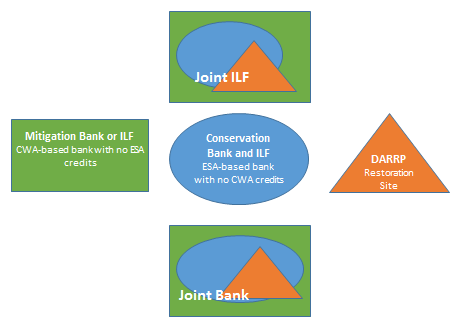Mitigation Banks, Conservation Banks, and In-Lieu Fee Programs in the West Coast Region
Mitigation banks and in-lieu fee programs are important tools to help meet conservation objectives.
Mitigation banks and in-lieu fee programs are important tools to help meet conservation objectives. They also help streamline Endangered Species Act (ESA) and Essential Fish Habitat (EFH) consultations and add predictability to the regulatory processes. We work with federal and state agencies, tribes, local governments, industry, non-governmental organizations, and other partners to support quality compensatory mitigation.

Hood Canal ILF, WA, eelgrass meadow at Little Anderson site. Photo by Scott Brewer
What is Mitigation?
Mitigation can be used to support NOAA’s work to conserve and manage coastal, riverine, and marine resources. NOAA conducts mitigation activities in accordance with our existing authorities. Generally, there are three categories or types of mitigation:
- Avoid—avoid the impact altogether by not taking a certain action or parts of an action or by modifying the action.
- Minimize—minimize the impact by limiting the degree or magnitude of the action and its implementation.
- Compensate—compensate for the impact by replacing or providing substitute resources or environments.
This characterization of the term mitigation is based on the definition of mitigation in the Council on Environmental Quality (CEQ) National Environmental Policy Act regulations (40 CFR 1508.20). The CEQ mitigation definition states that ‘‘Mitigation includes: avoiding the impact altogether by not taking a certain action or parts of an action; minimizing impacts by limiting the degree or magnitude of the action and its implementation; rectifying the impact by repairing, rehabilitating, or restoring the affected environment; reducing or eliminating the impact over time by preservation and maintenance operations during the life of the action; and compensating for the impact by replacing or providing substitute resources or environments.’’ As a practical matter, the five mitigation elements in the CEQ definition are categorized into three general types: avoidance, minimization (including rectifying and reducing), and compensatory mitigation.
More about NOAA's mitigation policy
Different Types of Banks
Mitigation is an important component of NMFS work when implementing several of our authorities including the Endangered Species Act (ESA), essential fish habitat (EFH) pursuant to the Magnuson-Stevens Fishery Conservation and Management Act (MSA), the Federal Power Act, the Fish and Wildlife Coordination Act (FWCA), and the Damage Assessment Remediation and Restoration Program (DARRP). Depending on the authorities guiding mitigation, banks and ILFs have different names (Figure 1). Usually, banks established under Clean Water Act authority under the oversight of the US Army Corps of Engineers are called mitigation banks. Banks that provide mitigation for impacts to ESA-listed species habitat are called conservation banks, and banks that provide compensatory mitigation for DARPP cases are referred to as restoration banks. Joint banks and ILFs can provide mitigation under several different authorities including state requirements. Information on all types of banks and ILFs and their available credits is housed on the Regulatory In-lieu Fee and Bank Information Tracking System (RIBITS).

Figure 1: Different Types of banks and ILFs
Benefits of Mitigation, Banks and ILFs
Mitigation can help achieve conservation objectives like the increase in critical functioning habitat for protected species and EFH for managed species while allowing for development. As such, mitigation can facilitate and streamline ESA and EFH consultations and permitting. When mitigation is provided in the form of a bank or ILF, benefits include economy of scale and certainty of success. Banks and ILF sites usually mitigate for larger and many different individual impacts. This economy of scale allows for more effort in site selection, development of quality mitigation plans, monitoring, and oversight compared to smaller (permittee responsible) mitigation. Thus, banks and ILFs usually result in high quality mitigation.
Specific Banks and ILFs on the West Coast
On the West Coast, there are several conservation banks and in lieu fee programs.
Three banks that highlight these innovative and successful approaches include: Bullock Bend in California, Alder Creek Restoration Project in Oregon, and Hood Canal Coordinating Council In-Lieu Fee (ILF) Program in Washington.
Read more about these programs
A list of all the approved banks and programs that we participate in on the West Coast, can be found here:
Approved Banks and In Lieu Fee Programs in the West Coast Region (PDF, 3 pages)
Habitat Conservation Calculator
In Puget Sound, we developed a science-based tool to support and inform the use of conservation banks and similar approaches. This “conservation calculator” assesses the value of nearshore habitat so that project proponents can gauge the impacts of their projects. The calculator reflects either a credit, if habitat is improved, or a debit, if habitat is lost. That way, project developers can objectively determine what, if anything, they must do to offset impacts on essential habitat for threatened Puget Sound Chinook salmon and other salmonids. The calculator is specific to Puget Sound and is an innovative approach to habitat conservation.
Banking and ILF Resources
Mitigation banking and ILFs offer opportunities for a variety of landowners through preservation of existing high-quality habitat, restoration of habitat in degraded areas, and/or establishment of habitat where needed to conserve NOAA Fisheries trust resources. Private, tribal, and government lands are all eligible for participation, although federal lands may require special consideration. We recommend that you review the NOAA Fisheries mitigation policy and the relevant resources listed below before contacting a regional NMFS office with jurisdiction for the credits you are seeking.